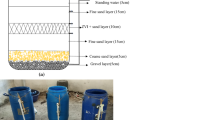Abstract
The most retentive glass fibre filters were able to retain almost all bacteria from the water of an oligotrophic lake. Having satisfactory speed and capacity, of filtration this type of filter is quite near to the ideal which should be able to include all algae and bacteria in the category of particulate organic carbon. Similar retention could also be achieved by silver filters but, because of their high blank values, price, and lower filtration speed and capacity, they are not able to compete with glass fibre filters in practical work.
Similar content being viewed by others
References
Gordon, D. D. & Sutcliffe, W. H. 1974. Filtration of seawater using silver filters for particulate nitrogen and carbon analysis. Limnol. Oceanogr. 19: 989–993.
Lock, M. A., Wallis, P. M. & Hynes, H. B. N. 1977. Colloidal organic carbon in running waters. Oikos 29: 1–4.
Meakin, J. C. & Pratt, M. C. 1972. Manual of laboratory filtration. W. & R. Balson Ltd, Maidstone, England, 110 pp.
Quinn, J. G. & Meyers, P. A. 1971. Retention of dissolved organic acids in seawater by various filters. Limnol. Oceanogr. 16: 129–131.
Salonen, K. 1974. Effectiveness of cellulose ester and perforated polycarbonate membrane filters in separating bacteria and phytoplankton. Ann. Bot. Fennici 11: 133–135.
Salonen, K. 1979a. A multiple filtration device for glass fibre filters. Hydrobiologia 67: 27–32.
Salonen, K. (1979b). A versatile method for the rapid and accurate determination of carbon by high temperature combustion. Limnol. Oceanogr. 24: 177–183.
Sharp, J. H. 1974. Improved analysis for ‘particulate’ organic carbon and nitrogen from seawater. Limnol. Oceanogr. 19: 984–989.
Sheldon, R. W. 1972. Size separation of marine seston by membrane and glass-fiber filters. Limnol. Oceanogr. 17: 494–498.
Sorokin, Y. I. & Overbeck, J. 1972. Direct microscopic counting of micro-organisms. In: Techniques for the assesment of microbial production and decomposition in fresh waters, Y. I. Sorokin & H. Kadota (eds.), IBP Handbook No 23: 44–47, Blackwell Scientific Publications, Oxford, 112 pp.
Wangersky, P. J. 1975. Measurement of organic carbon in seawater. In: Analytical methods in oceanography, R. P. Gibb, Jr. (ed.), Advances in chemistry series, number 147: 148–162, American Chemical Society.
Author information
Authors and Affiliations
Rights and permissions
About this article
Cite this article
Salonen, K. Comparison of different glass fibre and silver metal filters for the determination of particulate organic carbon. Hydrobiologia 67, 29–32 (1979). https://doi.org/10.1007/BF00020875
Received:
Issue Date:
DOI: https://doi.org/10.1007/BF00020875




